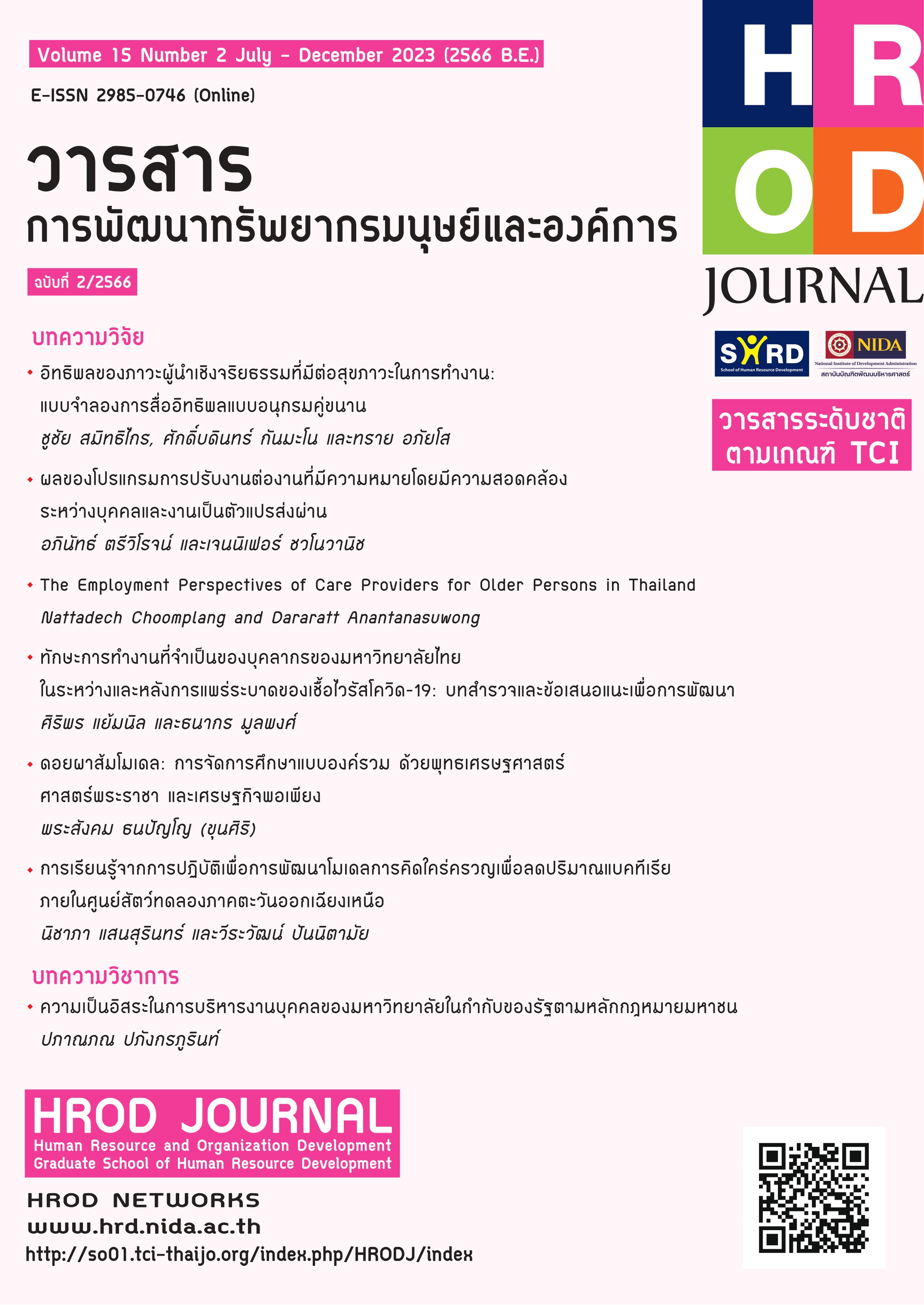Doi Phasom Model: A Holistic Education Through Buddhist Economics, King Rama 9’s Sciences and Sufficiency Economy
Main Article Content
Abstract
This research aims to (1) study the pattern, method, and process in organizing the Learning Center for the Operation of Sufficiency Economy Philosophy (LCOSEP) of Wat Phra Borommathat Doi Phasom (WPBDP) Located in Samoeng District, Chiang Mai Province, Thailand, (2) propose a human development model for sustainable well-being, and (3) evaluate the success of LCOSEP of WPBDP. This research adopted the mixed analysis of both quantitative and qualitative methods that employed data collection with 129 persons living in the WPBDP community and the LCOSEP’s stakeholder with 14 persons and two monks for in-depth interview. The results of the research revealed that was due to the determination of the monk has built the villagers' faith that confidence and is ready to create an education model for human and social development that used to solve problems with student-centered education with a blend of Buddhist economics, The Late King Rama 9’s Sciences, and the Sufficiency Economy Philosophy. The evaluation results of the sustainable health PERMA Model were at the highest level in all components, and the CIPPIEST Model was used to evaluate the success of the LCOSEP project that overall indicated a very good level, and which is consistent with the results of the qualitative assessment that everyone gave the highest weight to the happiness they received in their respective status.
Article Details

This work is licensed under a Creative Commons Attribution-NonCommercial-NoDerivatives 4.0 International License.
1) The content of article in HROD journal is the author’s wholly responsibility to research, analyze, summarize, compile, and reference data. The editorial department will not be responsible in anyway.
2) The submitted articles in HROD journal must be unpublished before and must not be currently under consideration for publication elsewhere. If it is detected for its repetition, the author must be responsible for infringement of copyright.
3) Authors will be asked to transfer copyright of the article to the Publisher. The article is prohibited to reproduce all or part of the text, unless allowed.
References
กระทรวงศึกษาธิการ. (2551). หลักสูตรแกนกลางการศึกษาขั้นพื้นฐาน พ.ศ.2551. สำนักวิชาการและมาตรฐานการศึกษา.
พระธรรมปิฎก (ป.อ. ปยุตฺโต). (2540). พระพุทธศาสนาพัฒนาคนและสังคม. กรมการปกครอง.
พระมหาสุทิตย์อาภากโร และ เขมณัฏฐ์ อินทรสุวรรณ. (2553). ตัวชี้วัดความสุข: กลยุทธ์การสร้าง และการใช้เพื่อชุมชนเป็นสุข (พิมพ์ครั้งที่ 2). ริชแมกซ์อินเตอร์พริ้น.
สาโรช บัวศรี. (2553). รำลึกคุณูปการศาสตราจารย์ ดร. สาโรช บัวศรี. สถาบันวัฒนธรรมและศิลปะ มหาวิทยาลัยศรีนครินทรวิโรฒ.
สำนักงานนวัตกรรมแห่งชาติ. (2548). นวัตกรรมประเทศไทย: กรณีศึกษาประสบการณ์จากสหรัฐอเมริกา สหภาพยุโรปและยุทธศาสตร์การสร้างนวัตกรรมสำหรับประเทศไทย. สำนักงานนวัตกรรมแห่งชาติ.
อภิชัย พันธเสน. (2544). พุทธเศรษฐศาสตร์. สำนักพิมพ์อมรินทร์.
อภิชัย พันธเสน. (2547). พุทธเศรษฐศาสตร์ วิวัฒนาการทฤษฎีและการประยุกต์กับคณะอนุกรรมการขับเคลื่อนเศรษฐกิจพอเพียง. คณะกรรมการพัฒนาการเศรษฐกิจและสังคมแห่งชาติ.
อภิชัย พันธเสน. (2559, 26 ตุลาคม). พุทธเศรษฐศาสตร์ที่มาปรัญญาเศรษฐกิจพอเพียง ตอน 1. Youtube. https://www.youtube.com/watch?v=ETRdpuMrOCk
อลงกรณ์ คูตระกูล. (2553). นวัตกรรมสังคม: กรณีศึกษาโครงการของท้องถิ่นในเขตภาคเหนือของประเทศไทย [วิทยานิพนธ์ปริญญาดุษฎีบัณฑิต ไม่ได้ตีพิมพ์]. สถาบันบัณฑิตพัฒนบริหารศาสตร์.
Ernst Friedrich Schumacher. (1999). Small is beautiful: Economics as if people mattered: 25 years later with commentaries. Hartley & Marks.
Hare, J. (2006). Toward an understanding of holistic education in the middle years of education. Journal of Research in International Education, 5(3), 23-25.
Howaldt, J., & Schwarz, M. (2010). Social innovation: Concepts, research fields and international trends. Retrieved from http://www.sfs-dortmund.de/odb/Repository/Publication/Doc%5C1289%5CIMO_Trendstudie_Howaldt_Schwarz_englische_Version.pdf
Millard, J. (2020). How social innovation underpins sustainable development. Retrieved from https://www.socialinnovationatlas.net/fileadmin/PDF/einzeln/01_SI-Landscape_Global_Trends/01_07_How-SI-Underpins-Sustainable-Development_Millard.pdf
Miller, R. (1997). What are schools for? Holistic education in American culture (3rd ed.). Holistic Education Press.
Mulgan, G., Tucker, S., Ali, R., & Sanders, B. (2007). Social Innovation: What it is, why it matters and how it can be accelerated. Skoll Centre for Social Entrepreneurship.
Nava, R. G. (2001). Holistic education: Pedagogy of universal love. Holistic Education Press.
Phills, J. A., Deiglmeier, K., & Miller, D. T. (2008). Rediscovering social innovation. Stanford Social Innovation Review, 6(4), 34-43.


